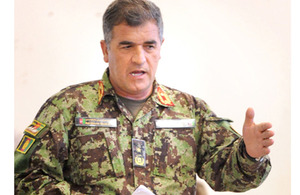Top Afghan commander helps prepare UK forces for deployment
The commander of Afghan troops who work alongside British forces to provide security in Helmand province has visited the UK to help our troops prepare for deployment to the area.

Brigadier General Sherin Shah [Picture: Corporal Mike O'Neill RLC, Crown Copyright/MOD 2012]
Brigadier General Sherin Shah, the Commander of 3rd Brigade of 215 Corps of the Afghan National Army (ANA), flew in to play a role in the force generation of UK military units for ongoing operations in Afghanistan - the sixth time he has done so.
While here he also expressed confidence that his men will be ready to take responsibility for their country’s security post-2014.
During the training he met the UK’s Brigadier Rupert Jones, Commander 1st Mechanized Brigade, which deploys on Operation Herrick 18 in the coming weeks.
Brigadier Jones will be the Afghan General’s counterpart and work closely with him over his brigade’s six-month tour.
During his visit, General Shah gave presentations on the capabilities of the ANA in Helmand province and took part in planning sessions for future operations as well as acting in his own role during training for the Afghan central Helmand security shura (meeting) which co-ordinates security priorities.
His advice, based on 10 years of fighting in southern Afghanistan, was immensely valuable.
There was also a chance for a reunion when he met UK Brigadier Patrick Sanders, who commanded more than 6,000 British personnel in Task Force Helmand over the winter of 2011/12 as Commander of 20th Armoured Brigade, and worked closely with the Afghan General.
General Shah, who was accompanied by Brigadier General Ayoub Ansari of the Afghan National Police, held meetings with British Defence Chiefs to discuss how UK forces prepare for deployments to Afghanistan is changing as their security responsibilities are increasingly handed over to their Afghan counterparts.
British forces are to draw down from 9,000 personnel to around 5,200 by the end of 2013 as transition of security control to the Afghan National Security Forces (ANSF) progresses. The transition, to be complete by the end of 2014, is on track and approximately 90 per cent of Afghans now live in areas where Afghan forces lead on security.
General Shah said:
I am confident we will be ready in 18 months’ time when ISAF combat operations stop.
When we started as a new army from scratch we needed a shoulder to lean on. As time has gone on we still have that shoulder, but have tested ourselves. We are at that stage now where the shoulder is still there, but we can stand on our own, and we can start to look at the day after tomorrow, when we will be walking or running.
Our turning point was last year, during 20 Brigade’s tour. That was when Task Force Helmand moved from our sides to our back, asked us what we needed rather than telling us what to do, and allowed us to find how capable we could be.
My proudest achievement is that over 70 per cent of my brigade are able to operate as commandos, independently, and the reports I have from the British personnel are of how amazed they are at the level of our soldiers.
As part of his visit, General Shah also attended seminars at the Royal College of Defence Studies and at All Souls College, Oxford University, which analysed the capabilities of the ANSF, the state of transition in Afghanistan and international relations matters involving Afghanistan.
He also visited No 10 Downing Street for a briefing with the National Security Adviser, Sir Kim Darroch, and met with senior military officers and officials at the Ministry of Defence to further discuss operations in Afghanistan.